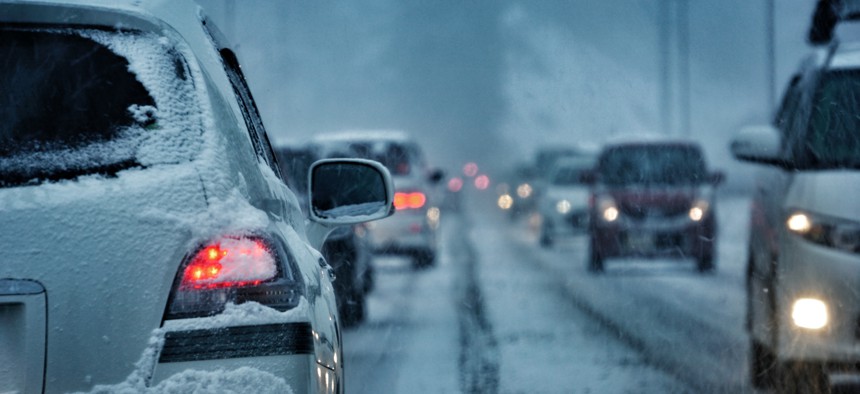Wintery Conditions Leave Thousands of Motorists Trapped on Highway For a Day

RFsnowstorm615314421
Drivers—including one U.S. senator—found themselves trapped in their cars in Virginia, some for more than 24 hours. But no deaths or injuries have been reported.
Thousands of motorists—including one U.S. senator—found themselves trapped in their cars in Virginia overnight Monday and all day Tuesday, as a winter snow storm brought traffic in both directions on Interstate 95 to a standstill. As of Tuesday night, cars were no longer stuck on the highway but some were still stranded on side roads, according to media reports.
The logjam raised questions about Virginia’s preparations for the storm and how other states could avoid similar fates.
The Virginia Department of Transportation closed a 48-mile segment of the notoriously clogged highway, as crashes, icy surfaces and abandoned vehicles made passage impossible. Some motorists reported on social media that they did not have food or water. Many worried about running out of fuel. Josh Lederman, a reporter for MSNBC who was among the motorists stuck on the highway, said he did not see snowplows or emergency responders for at least six hours.
“We know many travelers have been stuck on Interstate 95 in our region for extraordinary periods of time over the past 24 hours, in some cases since Monday morning. This is unprecedented, and we continue to steadily move stopped trucks to make progress toward restoring lanes,” VDOT engineer Marcie Parker said in a statement.
Katie Stuntz, communications director for Virginia Sen. Tim Kaine, tweeted at 3:55 p.m. that the lawmaker finally arrived in Washington, D.C. from Richmond after 27 hours on the road.
'Incredibly Unusual Event'
Virginia Gov. Ralph Northam told reporters Tuesday afternoon the backup was “an incredibly unusual event.” The changing weather, out-of-state drivers who might not have heard warnings to stay off the roads, and crashes that blocked travel in both direction all contributed, he said.
“Multiple tractor trailers jackknifed on the interstate. When that happens, it’s going to create a major backup, and it’s going to take time to clean up whether it happens in a winter storm on a sunny summer day,” he added.
Although many motorists were delayed, none were injured or killed. Northam also said that no local leaders had requested help from the National Guard. Instead, Virginia relied primarily on its state police to assist motorists. The police were able to respond to the crisis quicker than the Guard, which would have taken several hours to mobilize, he explained.
Part of the reason the situation got so bad is that the winter storm came so quickly. Temperatures plummeted from the 60s on Sunday to the low 30s by Monday morning, as the storm bringing six to10 inches of snow passed through the mid-Atlantic. In fact, the storm started with rain that eventually turned into snow, making it impossible for VDOT to pretreat roads with salt or other chemicals to prevent freezing.
When the snow did come, it came quickly. It accumulated at a rate of about two inches an hour. Parker told reporters that snow crews couldn’t keep up with that pace. “Could we have kept up with the snowfall rate of that amount? No. Pretty much when it gets over an inch an hour, we have a hard time,” he said.
‘Unprecedented’ but Not New
While Parker called the situation “unprecedented,” other states have had to cope with fast-developing storms that have stranded motorists, too.
At a safety event in November, Pennsylvania officials reminded motorists to stay off the road during winter storms.
“We’ve all seen the devastating effects of snow squalls throughout the state during the winter weather season,” Randy Padfield, the director of the Pennsylvania Emergency Management Agency, said. “These squalls have resulted in large, complex, multi- vehicle collisions that have closed roadways for long periods of time, injured and stranded motorists, and, tragically, have resulted in the loss of life.”
Two years ago, two people died and 30 more were injured in a pileup on Interstate 80 because of the winter weather, he noted.
Mountain states such as California and Colorado routinely close parts of their interstates during dangerous weather to avoid motorists getting stranded (although, as The New York Times recently reported, that can lead to drivers depending on Google Maps and Waze to take more treacherous routes).
When conditions are especially overwhelming, governors have called on the National Guard to aid the stranded motorists. At one point in 2015, eight states deployed Guard troops in those efforts.
A freakish 2014 snowstorm pummeled the South in February, leaving 11 dead and stranding motorists in North Carolina. The images of abandoned vehicles—including one car on fire—along a major thoroughfare became the fodder for internet memes and delayed motorists for hours.
North Carolina avoided the brunt of this week’s storm, which brought mostly heavy rain and winds, said Andrew Barksdale, a spokesperson for the North Carolina Department of Transportation.
“We did treat last night some trouble spots on our four-lane highways, bridges and elsewhere with salt or sand, because of the potential of black ice forming overnight. At its peak, we had about 65 storm-related road closures yesterday, and as of this morning, that number was down to about 40 road closures,” he said in an email.
“Our response to our storm worked well for this one, but we always look for improvements when new issues arise,” Barksdale added.
NEXT STORY: What Is Pay-As-You-Throw? A Waste






